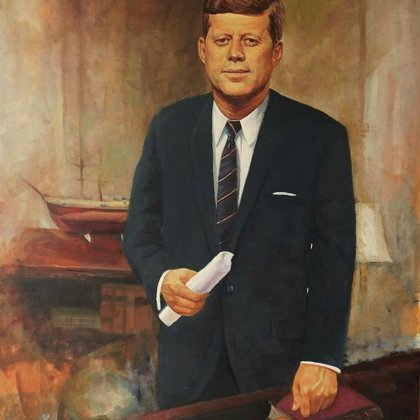JOHN FITZGERALD KENNEDY (1917 – 1963) WAS ELECTED THE 35TH PRESIDENT OF THE UNITED STATES AND SERVED FROM JANUARY UNTIL HIS ASSASSINATION IN NOVEMBER 1963.HE EXPLORED HIS FELLOW CITIZENS TO " ASK NOT WHAT YOUR COUNTRY CAN DO FOR YOU,ASK WHAT YOU CAN DO FOR YOUR COUNTRY".
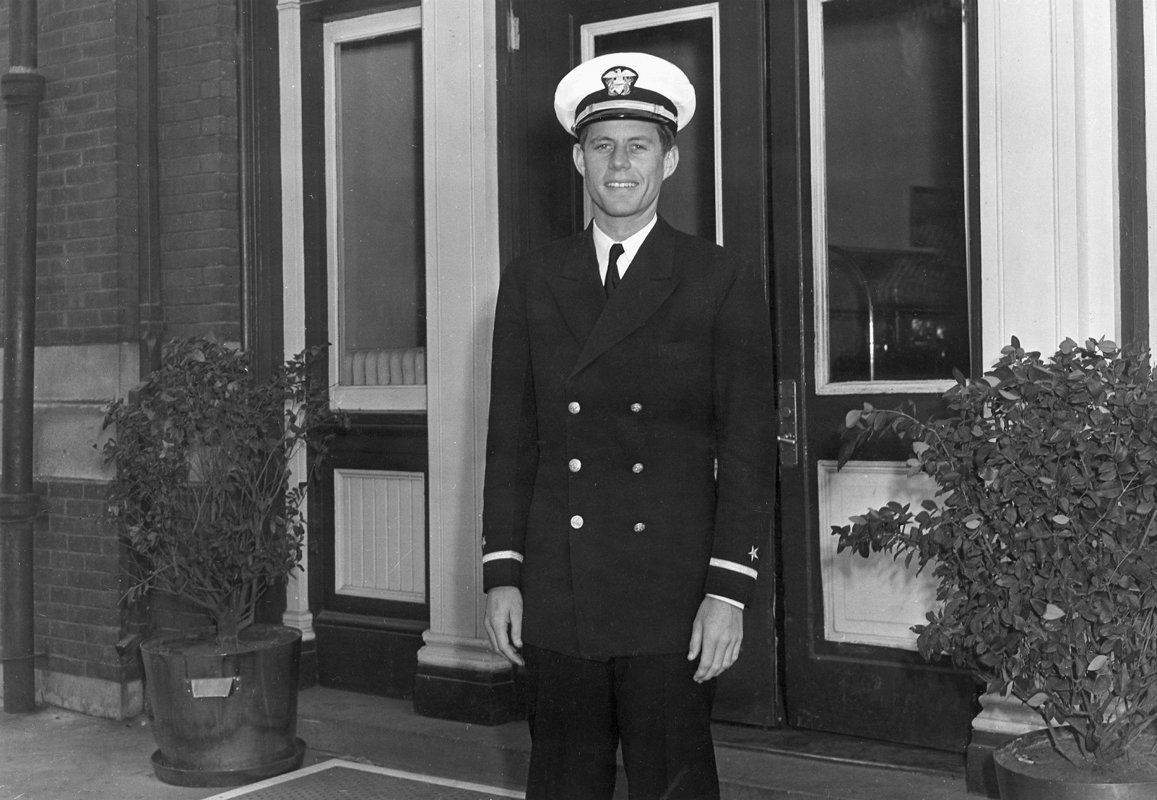 After graduating from Harvard, Kennedy attempted to fulfill his lifelong
dream of serving his country in the military. Unfortunately, because of
his chronic back pain and frequent illnesses, he was rejected by the
Army on medical grounds. After his father went to work behind the scenes
on JFK’s behalf, he was accepted into the Naval Reserves and
commissioned as an ensign in 1941.
After graduating from Harvard, Kennedy attempted to fulfill his lifelong
dream of serving his country in the military. Unfortunately, because of
his chronic back pain and frequent illnesses, he was rejected by the
Army on medical grounds. After his father went to work behind the scenes
on JFK’s behalf, he was accepted into the Naval Reserves and
commissioned as an ensign in 1941.
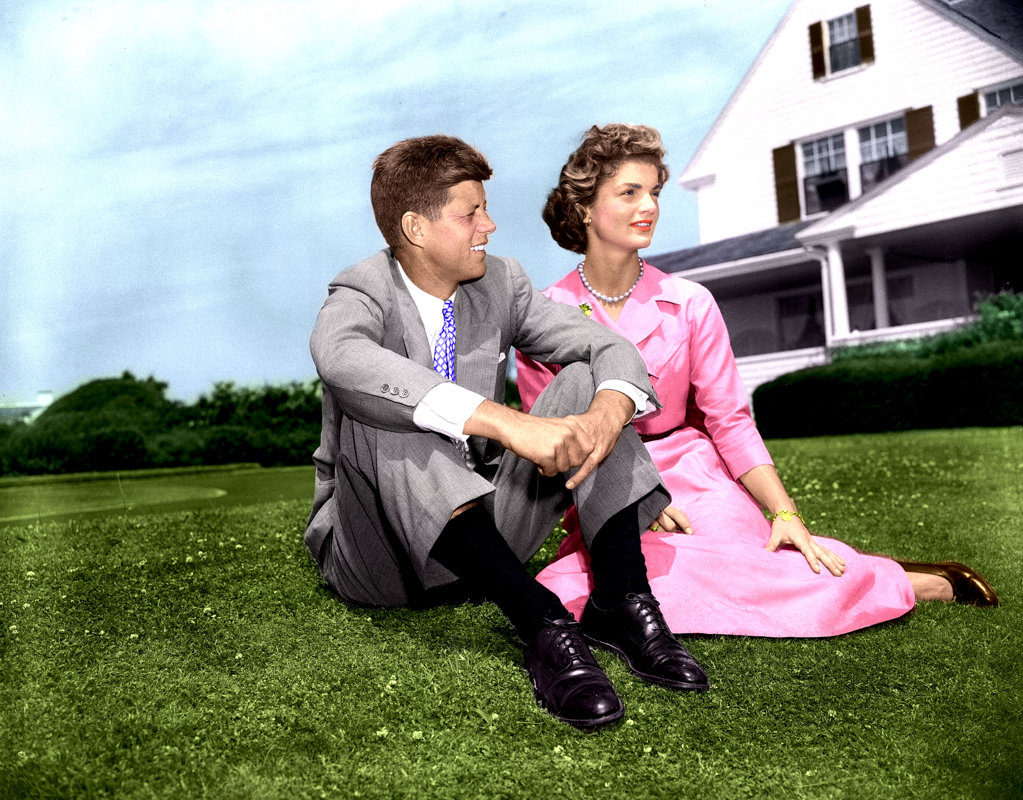 Senator John F. Kennedy and Jacqueline Lee Bouvier,
leave a Newport, Rhode Island, church following their wedding ceremony
in 1953. An estimated one thousand people waited outside the church for
the newlyweds.John Fitzgerald Kennedy becomes the
president of the Unites States and installs at the White House one of
the country’s most charismatic First couple. In the meantime, however,
Jackie Kennedy has discovered the insatiable sexual appetite of her
husband who leads numerous affairs with secretaries or Hollywood stars
such as Gene Tierney or Marilyn Monroe and the mockeries of the Kennedy
clan.
Senator John F. Kennedy and Jacqueline Lee Bouvier,
leave a Newport, Rhode Island, church following their wedding ceremony
in 1953. An estimated one thousand people waited outside the church for
the newlyweds.John Fitzgerald Kennedy becomes the
president of the Unites States and installs at the White House one of
the country’s most charismatic First couple. In the meantime, however,
Jackie Kennedy has discovered the insatiable sexual appetite of her
husband who leads numerous affairs with secretaries or Hollywood stars
such as Gene Tierney or Marilyn Monroe and the mockeries of the Kennedy
clan.
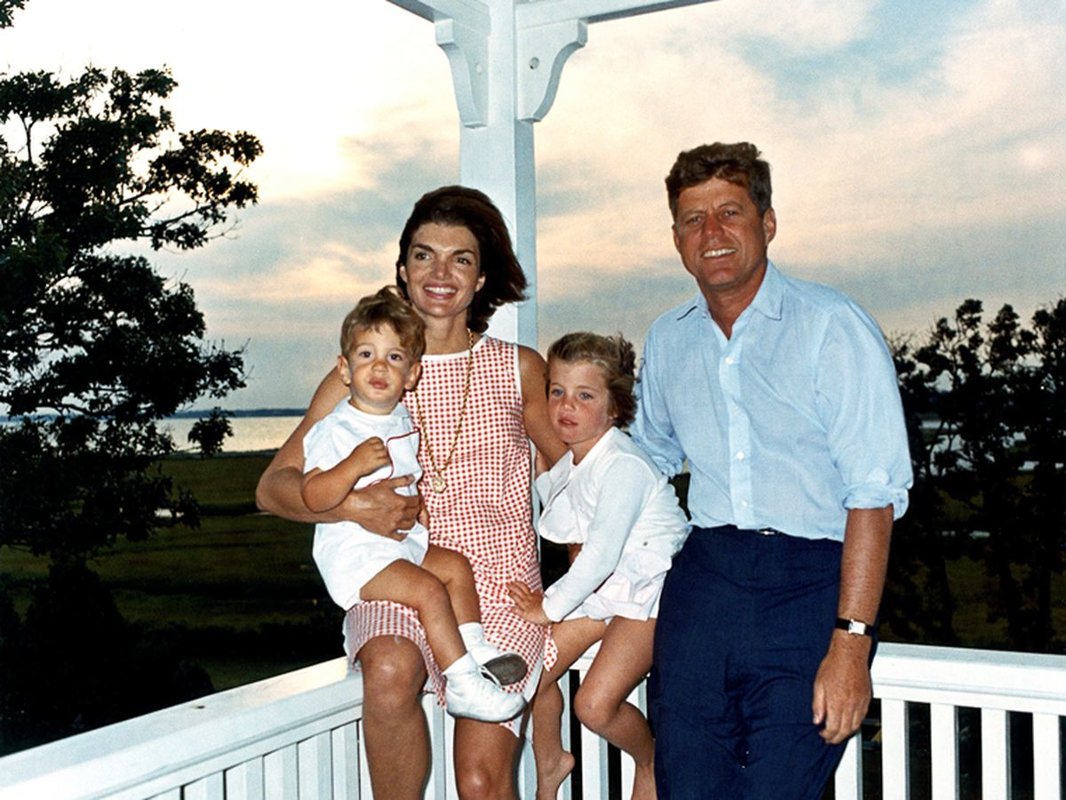 John F. Kennedy and First Lady Jackie Kennedy brought a new kind of
glamour to the White House. In the 1960s, the President Kennedy and his
wife were admired both nationally and internationally. Their style,
youth, and glamour made the couple iconic. One thing historians have
agreed on though is that both John and Jackie were quite private in one
particular area – their children Caroline and John Kennedy Jr.
John F. Kennedy and First Lady Jackie Kennedy brought a new kind of
glamour to the White House. In the 1960s, the President Kennedy and his
wife were admired both nationally and internationally. Their style,
youth, and glamour made the couple iconic. One thing historians have
agreed on though is that both John and Jackie were quite private in one
particular area – their children Caroline and John Kennedy Jr.
John F Kennedy (known as JFK) (1917 - 1963 ) was the 35th president of the United States, an immensely popular leader who was assassinated before he completed his third year in office. John Fitzgerald Kennedy was born in Brookline, Massachusetts, on May 29, 1917. He was the second son of nine children born to the multimillionaire business executive and financier Joseph P. Kennedy (1888–1969) and his wife, Rose Fitzgerald Kennedy (1890–1995). Joseph's father had served in the Massachusetts Legislature and in elective offices in Boston, Massachusetts. Rose's father, John Francis Fitzgerald (1863–1950), had been a state legislator, the mayor of Boston, and a U.S. congressman. Joseph himself had served as chairman of the Securities and Exchange Commission, chairman of the U.S. Maritime Commission, and ambassador to Great Britain (1937–40). Thus, the Kennedys were a wealthy family with a history of political and public service.Kennedy attended the Canterbury parochial school (1930–31) and the Choate School (1931–35). One of his teachers later said that people in school liked him more for his personality than for his accomplishments. He was often ill during his childhood and spent much of this time reading. Kennedy enrolled at Princeton University in 1935 but illness soon forced him to withdraw. Upon recovery he went to Harvard University, where he majored in government and international relations. During his junior year at Harvard, he traveled in Europe and observed the events that were leading to World War II (1939–45; a war in which the AlliesFrance, Great Britain, the Soviet Union, China, and from 1941 the United Statesfought against the Axis powers Germany, Italy, and Japan). He used his observations for his senior paper, which later became the bestselling book Why England Slept (1940).After graduating from Harvard with honors in 1940, Kennedy went to Stanford University for graduate studies. In April 1941 he tried to enlist in the U.S. Army but was rejected for physical reasons . Months later, after his back strengthened through a regimen of exercises, the U.S. Navy accepted him. He then became an intelligence officer in Washington, D.C. After the Japanese attack on Pearl Harbor, a U.S. Navy base in Hawaii, on December 7, 1941, the United States entered World War II. Kennedy requested active duty at sea and was given this assignment in late 1942.FK's political outlook wasn't as left-wing as many believe. He even said on record that he was not a liberal.Kennedy was a fan of fine cigars, and Cuban cigars in particular. In February of 1962, he asked press secretary Pierre Salinger to help him acquire a large supply of Cuban cigars and quickly. When Salinger asked how many he needed, Kennedy told him, "About 1000 Petit Upmanns." And he wanted them by the next morning. The next day, when Salinger informed the president that he had managed to get 1200 of them, he wrote that, “Kennedy smiled, and opened up his desk. He took out a long paper which he immediately signed. It was the decree banning all Cuban products from the United States. Cuban cigars were now illegal in our country.Fleming's advice to Kennedy may have been taken seriously. During his presidency, Kennedy authorised a top secret CIA programme called "Operation Mongoose" which aimed to topple Fidel Castro’s Cuban regime via clandestine activities. The operation cost the US $50 million per year and included negotiations with mafia personnel to try and get them to assassinate the communist leader.On August of 1956 (before Kennedy was elected president), Jackie, unfortunately, gave birth to a stillborn infant named Arabella Kennedy. At the specific time when this occurred, Senator Kennedy was on a yacht in the Mediterranean with friends.In November of 1957, Jackie Kennedy gave birth to a lovely little girl – Caroline. John F. Kennedy was very fond of his daughter, and many have said that the new-found bond steered him on a path towards maturity as a husband and father.In November 1960, Jackie Kennedy gave birth again to a bouncing baby boy at Georgetown hospital. It turned out that initial reports of good health were misleading, and that the baby was actually born prematurely . The infant – John Kennedy Jr. – had respiratory issues at birth, and did not squall when the doctor slapped him on the buttocks. It took the quick thinking of a pediatric resident who inserted a tube into the baby’s trachea and blew air into his lungs for the little Kennedy to respond.On August of 1963, when John Kennedy was in office as president, Jackie went into about five weeks earlier. She was transported by helicopter to Otis Air Force Base where she gave birth to a Patrick. The newborn, born way too early, was suffering from a hyaline membrane and struggled to breathe. Despite the Boston Globe popularly declaring “He’s a Kennedy – He’ll Make It”, Patrick lost the battle 39 hours later. The loss was one of the hardest moments for the president and the first lady. However tragic, the loss appeared to bring them closer to each other.Of the four pregnancies, only Caroline and John Jr. made it to adulthood.
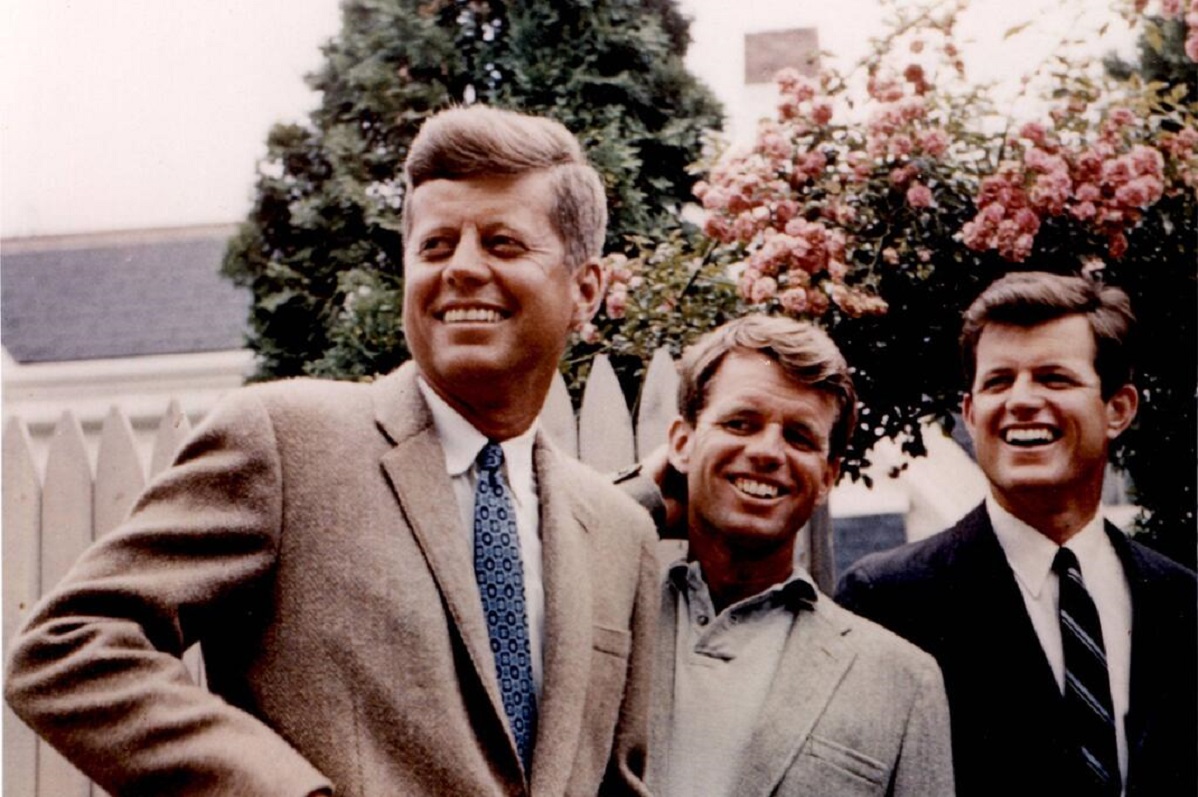 John Kennedy ,Robert and Ted Kennedy,John F. Kennedy, nicknamed "Jack," was the second
oldest of a group of nine extraordinary siblings. His brothers and
sisters include Eunice Kennedy, the founder of the Special Olympics;
Robert Kennedy, a U.S. Attorney General; and Ted Kennedy, one of the
most powerful senators in American history. The Kennedy children
remained close-knit and supportive of each other throughout their entire
lives.
John Kennedy ,Robert and Ted Kennedy,John F. Kennedy, nicknamed "Jack," was the second
oldest of a group of nine extraordinary siblings. His brothers and
sisters include Eunice Kennedy, the founder of the Special Olympics;
Robert Kennedy, a U.S. Attorney General; and Ted Kennedy, one of the
most powerful senators in American history. The Kennedy children
remained close-knit and supportive of each other throughout their entire
lives.
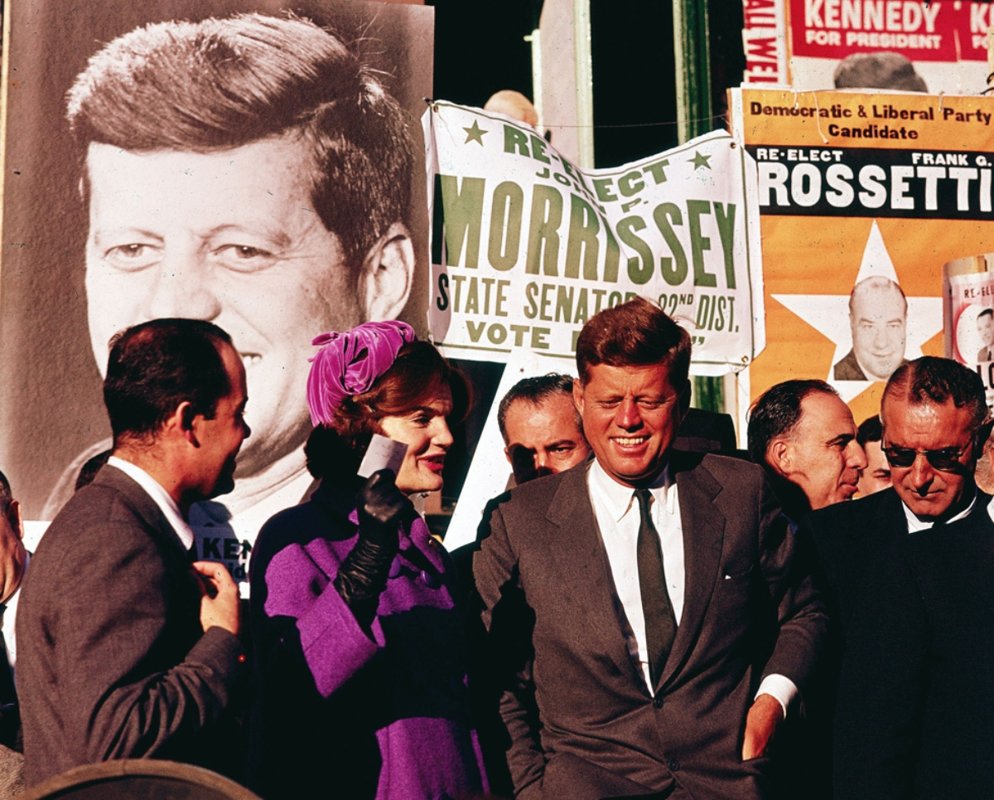 Perhaps Jackie’s greatest contribution and success as a partner to her
husband during his presidential campaign was through her syndicated
column “Campaign Wife” that ran weekly in newspapers across the country
from September 17 to November 1, 1960. Using personal stories and her
own perspective on campaign issues, Jackie wrote primarily for the
audience of women who were interested in her role as the candidate’s
wife. She addressed a wide variety of topics, including writing about
her interest in education as a campaign issue, responding to remarks
about her appearance, and encouraging voters to “Call for Kennedy” and
to arrange debate-watching parties.
Perhaps Jackie’s greatest contribution and success as a partner to her
husband during his presidential campaign was through her syndicated
column “Campaign Wife” that ran weekly in newspapers across the country
from September 17 to November 1, 1960. Using personal stories and her
own perspective on campaign issues, Jackie wrote primarily for the
audience of women who were interested in her role as the candidate’s
wife. She addressed a wide variety of topics, including writing about
her interest in education as a campaign issue, responding to remarks
about her appearance, and encouraging voters to “Call for Kennedy” and
to arrange debate-watching parties.
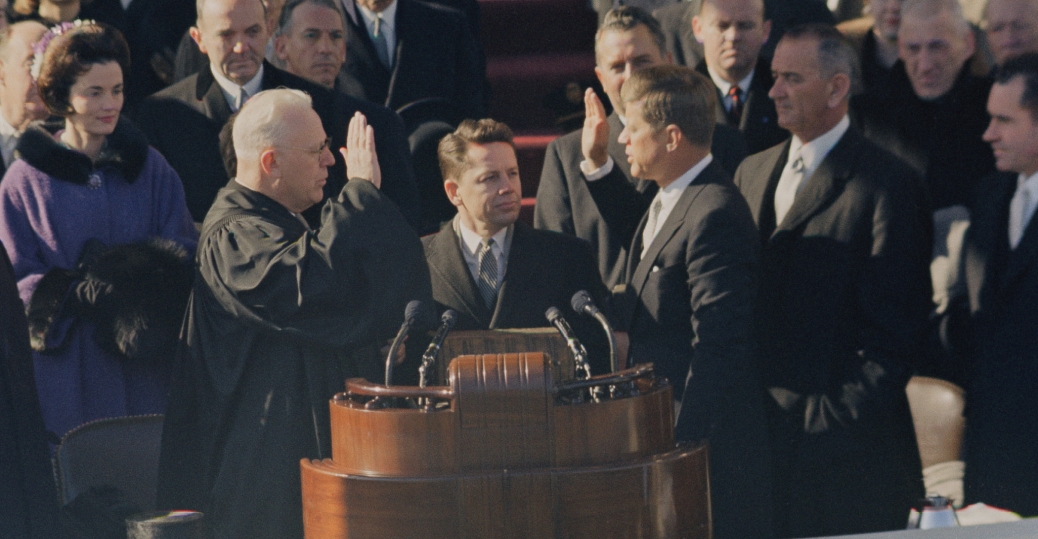 1961:
John F Kennedy sworn in as US president.The Democrat John F Kennedy has
been sworn in as the youngest ever elected president of the United
States.The 43-year-old Roman Catholic was inaugurated as the 35th
president
on a snow-covered Capitol Hill in Washington. He takes over from the
oldest president in American history, General Dwight Eisenhower, who is
bowing out aged 70.
1961:
John F Kennedy sworn in as US president.The Democrat John F Kennedy has
been sworn in as the youngest ever elected president of the United
States.The 43-year-old Roman Catholic was inaugurated as the 35th
president
on a snow-covered Capitol Hill in Washington. He takes over from the
oldest president in American history, General Dwight Eisenhower, who is
bowing out aged 70.
The Election of 1960,it was one of the closest
elections in American history.The Republican insider was Richard Nixon
of California, relatively
young but experienced as the nation's Vice-President for 8 years under
Dwight Eisenhower. The Democratic newcomer was John F. Kennedy,
senator from Massachusetts, who at the age of 43 could become the
youngest person ever to be elected President.Kennedy’s
selection of Lyndon Johnson as Vice President anchored significant
southern support at the risk of alienating northern liberals. Kennedy
moved to recover disenchanted liberal support by courting leading
liberals. Regardless of the outcome,
the United States would for the first time have a leader born in the
20th century.Age was not the only factor in the election. Kennedy was also Roman
Catholic, and no Catholic had ever been elected President before. Al Smith, a Catholic, suffered a crushing defeat to Herbert Hoover
in 1928. This raised serious questions about the electability of a
Catholic candidate, particularly in the Bible Belt South. Questions were
raised about Kennedy's ability to place national interests above the
wishes of his Pope.o mollify these concerns, Kennedy addressed a group of Protestant
ministers. He pledged a solid commitment to separation of church and
state. Despite his assurances, his faith cost him an estimated 1.5
million votes in November 1960. Nixon decided to leave religious issues
out of the campaign and hammer the perception that Kennedy was too
inexperienced to sit in the Oval Office.Nixon stressed his steadfast commitment to fighting communism. He had
made a name for himself as a staunch red-baiter in the post-war era,
leading the charge against alleged spy Alger Hiss.
Nixon emphasized the importance of his 8 years as Vice-President. The
Soviet Union and China were always pressing, and America could ill
afford a President who had to learn on the job.Kennedy stressed his character, assisted by those in the press who
reported stories about his World War II heroism. While he was serving in
the South Pacific aboard the PT109, a
Japanese destroyer rammed his ship and snapped it in two. Kennedy
rescued several of his crewmates from certain death. Then he swam from
island to island until he found a group of friendly natives who
delivered a distress message Kennedy had carved into a coconut to an
American naval base. Courage and character became the major themes of
Kennedy's campaign.Although both candidates were seen as moderates on
nearly every
policy issue of the time, each hailed from different backgrounds.
Kennedy was from a wealthy background and graduated from Harvard
University. Nixon painted himself the average American, growing up poor
in California, and working his way through Whittier College.n an attempt
to broaden his base, Kennedy named one of his opponents
for the Democratic nomination his Vice-President. Lyndon Johnson was
older and much more experienced in the Senate. Johnson was from Texas,
an obvious attempt by Kennedy to shore up his potential weaknesses in
the South. Nixon named Massachusetts Senator Henry Cabot Lodge
as his running mate to attack Kennedy in his region of greatest
strength.In such a close contest, every event matters. Many analysts
suggest
that the decisive battle in the campaign was waged during the televised
Presidential debates. Kennedy arrived for the debates well-tanned and
well-rested from Florida, while Nixon was recovering from a knee injury
he suffered in a tiresome whistle-stop campaign. The Democrat was
extremely telegenic and comfortable before the camera. The Republican
was nervous, sweated profusely under the hot lights, and could not seem
to find a makeup artist that could hide his five o'clock shadow.Radio
listeners of the first debate narrowly awarded Nixon a victory,
while the larger television audience believed Kennedy won by a wide
margin. When the votes were tallied in November, Kennedy earned 49.7% of
the popular vote to Nixon's 49.5%. Kennedy polled only about 100,000
more votes than Nixon out of over 68 million votes cast. The electoral
college awarded the election to Kennedy by a 303-219 margin, despite
Nixon winning more states than Kennedy.Nixon’s was known for running
tough, ruthless campaigns, and the
Kennedy team anticipated smear tactics. It acted by publishing a
‘Campaign Sourcebook’ a condensed set of counter-arguments that,
together with the issues of experience and religion, also addressed
concerns over Kennedy’s health.On the latter issue Kennedy had also
procured the services of two
prominent physicians, who issued a statement declaring that he was fully
capable of ‘meeting any obligation of the Presidency without the need
for special medical treatment’. At best, this obscured the truth.The
president's Republican rival, Richard Nixon, who came a close second in
the race for the White House, also attended the inauguration ceremony.Millions
watched the swearing-in of the new president on television. He chose to
wear formal dress, including a top hat, for the occasion.Ask not what your country can do for you - ask what you can do for your country.President
Kennedy began his speech by addressing "my fellow citizens" - the term
first used by President George Washington but rejected by later
presidents in favour of the less formal "my fellow Americans".His
ten-minute address appealed to Americans to unite in the fight against
the common enemy of man: tyranny, poverty, disease and war itself.For
the people of the world struggling against the "bonds of misery", the
president pledged, "our best efforts to help them help themselves".He continued: "If a free society cannot help the many who are poor, it cannot save the few who are rich."He also appealed to the Soviet Union to begin a new quest for peace.
"Let
both sides for the first time, formulate serious and precise proposals
for the inspection and control of arms and bring the absolute power to
destroy other nations under the absolute control of all nations," he
said.President
Kennedy closed his speech with the words: "Ask not what your country
can do for you - ask what you can do for your country. My fellow
citizens of the world, ask not what America will do for you, but what
together we can do for the freedom of man."
His words were greeted with rousing applause.
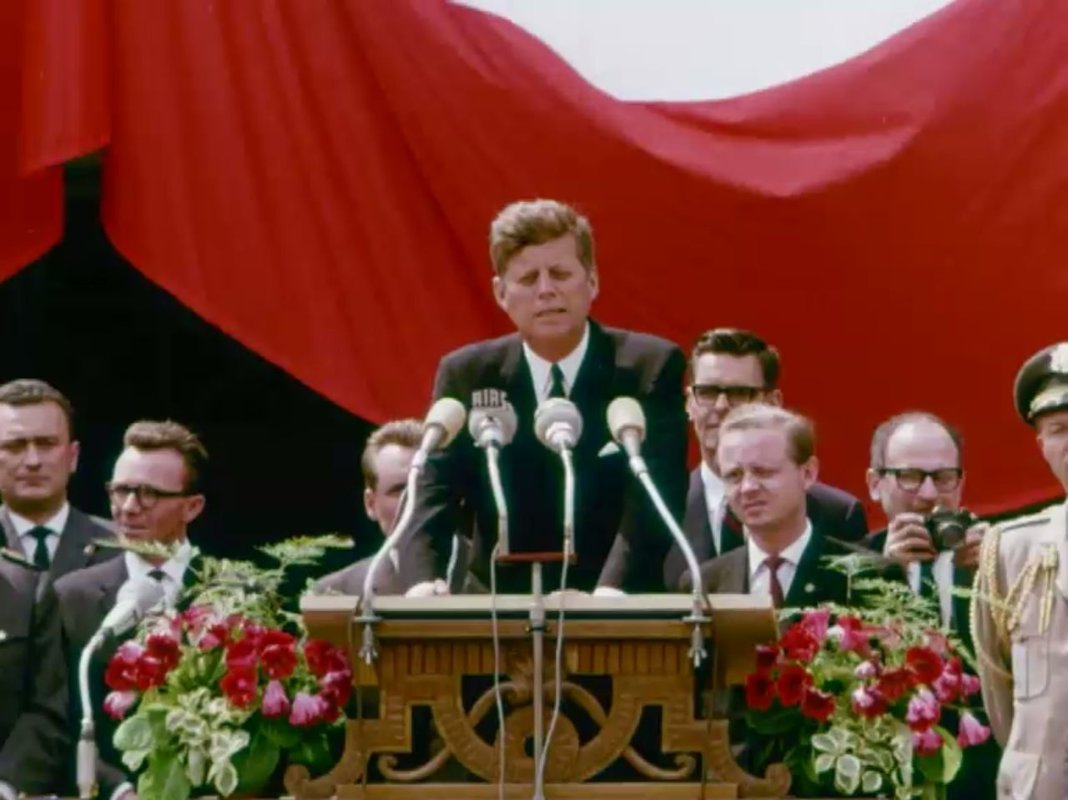 "Ich bin ein Berliner "- John F.
Kennedy's visit to Germany in 1963. The president received a rapturous
ovation at the podium before he had even begun. President
Kennedy speaks to students at Free University Berlin. He reaffirmed the
United States' support for Germany's reunification, and warned the
Soviet Union against ignoring NATO's commitment to Germany.
"Ich bin ein Berliner "- John F.
Kennedy's visit to Germany in 1963. The president received a rapturous
ovation at the podium before he had even begun. President
Kennedy speaks to students at Free University Berlin. He reaffirmed the
United States' support for Germany's reunification, and warned the
Soviet Union against ignoring NATO's commitment to Germany.
Entering the year 1961, Berlin was still divided. A third of it had been the Soviet Zone and was now a part of East Germany, otherwise known as the German Democratic, a Soviet invention in 1949. Republic. zones. The rest of Berlin was a part of the Federal Republic of Germany, otherwise known as West Germany, also founded in 1949. West Germany was a member of the military alliance called the North Atlantic Treaty Organization (NATO), which the Russians saw as a product of evil intentions.By treaty agreement dating back to Yalta in February 1945, US and other Western troops were free to patrol the Soviet zone in Berlin and Soviet troops were free to patrol the other zones in Berlin. Berlin was deep inside East German territory but the Soviets were supposed to provide free access from what was now West Germany to Berlin.East Germany's local communist-in-charge, Walter Ulbricht, was concerned about a serious loss of manpower, especially young people and skilled manpower passing freely into West Berlin and beyond to West Germany. Ulbricht convinced the Soviet leader Khrushchev that the border had to be closed. Khrushchev wanted better relations with the West and he wanted to talk to Kennedy to get an agreement on the Berlin issue.Kennedy and Khrushchev met in Vienna in early June, 1961, amid great fanfare and the parading of Jackie Kennedy and Nina Khrushchev in public, Jackie getting all the cheers. Meeting between the two men were planned as an informal exchange of views.At the meeting, Kennedy labored under the conception that the Soviet Union was bent on fomenting revolution around the world – a view reinforced by Khrushchev's pledge in January to assist movements of national liberation. And Khrushchev argued that it was not Soviet policy to try to make revolution, holding to his view that he merely wanted to assist others who were themselves changing their society. Khrushchev argued about balance of power, about Laos and nuclear testing. Having discussed with Ulbricht to question of closing the border between east and west Berlin, Khrushchev stressed the importance of an agreement on BerThe successful Berlin Airlift of 1948-49 was considered of little relevance as Khrushchev confronted Kennedy with a threat to sign a peace agreement with East Germany that would impinge on Western access to Berlin by turning over control of the access roads and air routes to the East Germans. Khrushchev said that the Soviet Union "would never, under any conditions, accept US rights in West Berlin" after it had signed a peace treaty with East Germany (Kempe, p. 247). Khrushchev resorted to what has been described as his usual bluster and threats. He told Kennedy that "force will be met by force," that it was for the United States to decide whether there will be war or peace and that his decision to sign a peace treaty with East Germany was irrevocable.Kennedy is described as having been shocked by the threats. This was not the friendly problem solving that he had been looking forward to. Kennedy insisted not that the US have continued access to East Berlin but that the US and its allies continue to have access to West Berlin. And Kennedy was to be described as having conveyed US acquiescence to the permanent division of Berlin.Khrushchev gave Kennedy an ultimatum, saying that the Soviet Union will sign the treaty by December 31 if the US refuses an interim agreement. To this, Kennedy replied, "Then, Mr. Chairman, there will be a war. It will be a cold, long winter."Kennedy's years in power were marked in foreign affairs by Cold War tension, together with a rhetorical commitment to introducing domestic reforms - most of all to expanding the civil rights of African Americans.In a speech delivered on nationwide television on July 25th, Kennedy told the American people that he recognized the "Soviet Union's historical concerns about their security in central and eastern Europe" and said he was willing to renew talks. He also announced that he would ask Congress for an additional $3.25 billion for military spending, mostly on conventional weapons. He announced that he wanted six new divisions for the Army and two for the Marines and announced plans to triple the draft and to call up the reserves. Kennedy proclaimed, "We seek peace, but we shall not surrender."On August 13, 1961, East Germany began closing the border between West and East Berlin, beginning with barbed wire. Ulbricht made a speech blaming his action on West Germany's "systematic plans for a civil war" which he said were "being executed by "revenge-seeking and militaristic forces." Ulbricht said he was closing the border for the "sole purpose" of providing security for East German citizens. The official name for the "Berlin Wall" was the "Anti-Fascist Protection Rampart." In Moscow, Khrushchev was looking at what he didn't realize would in the years ahead be a great propaganda defeat for what people in the West called "communism." Khrushchev said that he was aware that critics, "especially in bourgeois societies," would describe the Soviets as having locked down the East Germans against their will, but he excused the border closing as only a "temporary defect," and he drew from ideology in blaming Ulbricht for having failed to more effectively tap "the moral and material potential that would someday be harnessed by the dictatorship of the working classes." There was a rush of people to get out before the border was completely sealed. Families had become separated, and people accustomed to daily crossing into the West to work or pursue their businesses were suddenly more than inconvenienced. Some succeeded in swimming the 30 meters across the Spree Canal.
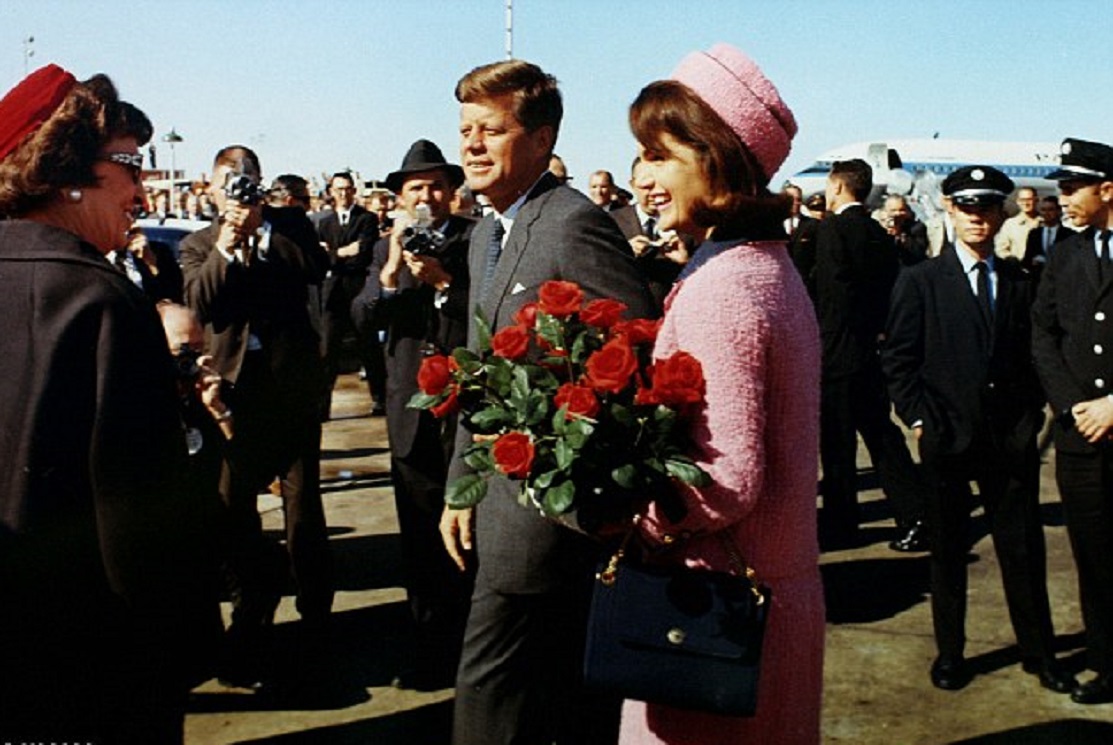
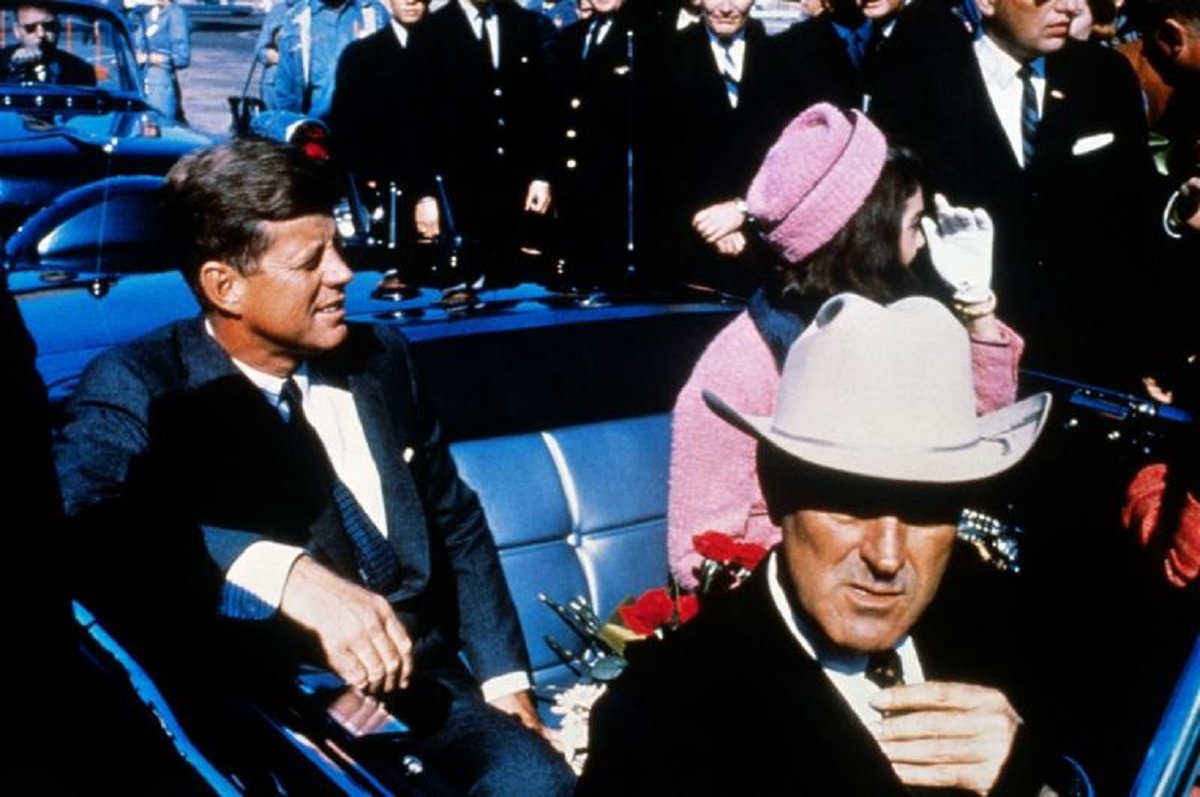
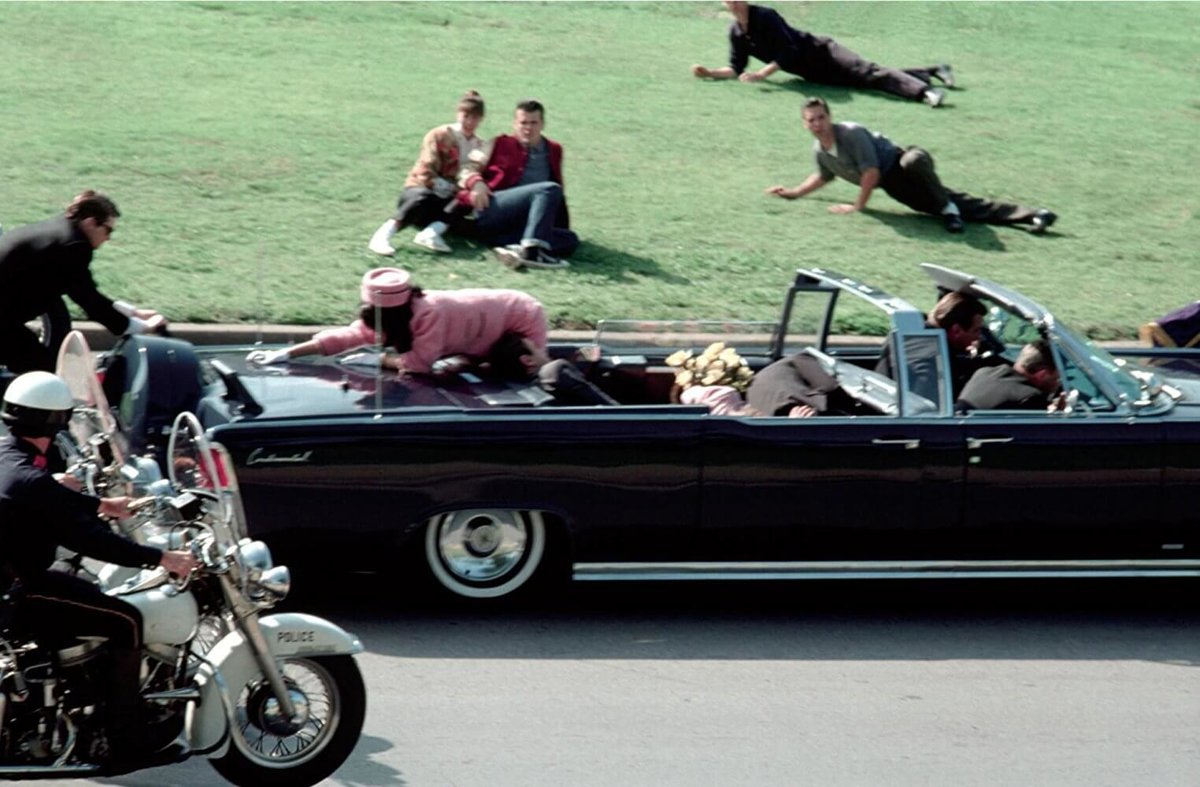 On November 21, 1963, President Kennedy flew to Dallas, Texas for a
campaign appearance. The next day, November 22, Kennedy, along with his
wife and Texas governor John Connally, rode through cheering crowds in
downtown Dallas in a Lincoln Continental convertible.Dallas, 22. November 1963, president John Fitzgerald Kennedy was shot and killed by assassination.
On November 21, 1963, President Kennedy flew to Dallas, Texas for a
campaign appearance. The next day, November 22, Kennedy, along with his
wife and Texas governor John Connally, rode through cheering crowds in
downtown Dallas in a Lincoln Continental convertible.Dallas, 22. November 1963, president John Fitzgerald Kennedy was shot and killed by assassination.On the fateful day of November 22nd, 1963, when President John F. Kennedy (JFK) was assassinated in Dallas, Texas, he and his wife, Jackie, had also visited another Texas city earlier that same day – Fort Worth, Texas.Fort Worth is the twin city of Dallas, commonly known today as the Dallas-Fort Worth metro area. But in 1963, Fort Worth would become the place where John F. Kennedy made his last two speeches.Dallas, 22. November 1963, president John Fitzgerald Kennedy was shot and killed by assassination.He died of a wound in the brain caused by a rifle bullet that was fired at him as he was riding through downtown Dallas in a motorcade.The official investigation found that Lee Harvey Oswald, acting alone, shot Kennedy from a warehouse window overlooking the president's motorcade route. Nevertheless, conspiracy theorists have speculated over the years that the full story has not been told. Some believe that classified documents held by the National Archives may identify the "real" killer of the president.Vice President Lyndon Baines Johnson, who was riding in the third car behind Mr. Kennedy's, was sworn in as the 36th President of the United States 99 minutes after Mr. Kennedy's death.Mr. Johnson is 55 years old; Mr. Kennedy was 46.Shortly after the assassination, Lee H. Oswald, who once defected to the Soviet Union and who has been active in the Fair Play for Cuba Committee, was arrested by the Dallas .He was accused of the killing.Oswald, 24 years old, was also accused of slaying a policeman who had approached him in the street. Oswald was subdued after a scuffle with a second policeman in a nearby theater.President Kennedy was shot at 12:30 P.M., Central standard time (1:30 P.M., New York time).After breakfast, the presidential party flew to Dallas.The trip took just 13 minutes, and Air Force One arrived at Love Field airport at 11:37 a.m. After getting off the plane, Kennedy and his wife shook hands with the crowd that awaited them. He was pronounced dead at 1 P.M. and Mr. Johnson was sworn in at 2:39 P.M.Mr. Johnson, who was uninjured in the shooting, took his oath in the Presidential jet plane as it stood on the runway at Love Field. The body of Mr. Kennedy was aboard. Immediately after the oath-taking, the plane took off for Washington.Standing beside the new President as Mr. Johnson took the oath of office was Mrs. John F. Kennedy. Her stockings were spattered with her husband's blood.Gov. John B. Connally Jr. of Texas, who was riding in the same car with Mr. Kennedy, was severely wounded in the chest, ribs and arm. His condition was serious, but not critical.The killer fired the rifle from a building just off the motorcade route. Mr. Kennedy, Governor Connally and Mr. Johnson had just received an enthusiastic welcome from a large crowd in downtown Dallas.Mr. Kennedy apparently was hit by the first of what witnesses believed were three shots. He was driven at high speed to Dallas's Parkland Hospital. There, in an emergency operating room, with only physicians and nurses in attendance, he died without regaining consciousness.Mrs. Kennedy, Mrs. Connally and a Secret Service agent were in the car with Mrs. Kennedy and Governor Connally. Two Secret Service agents flanked the car. Other than Mr. Connally, none of this group was injured in the shooting. Mrs. Kennedy cried "Oh no!" immediately after her husband was struck.Mrs. Kennedy was in the hospital near her husband when he died, but not in the operating room. When the body was taken from the hospital in a bronze coffin about 2 P.M., Mrs. Kennedy walked beside it.Her face was sorrowful. She looked steadily at the floor. She still wore the raspberry-colored suit in which she had greeted welcoming crowds in Fort Worth and Dallas. But she had taken off the matching pillbox hat she wore earlier in the day, and her dark hair was windblown and tangled. Her hand rested lightly on her husband's coffin as it was taken to a waiting hearse.Mrs. Kennedy climbed in beside the coffin. Then the ambulance drove to Love Field, and Mr. Kennedy's body was placed aboard the Presidential jet. Mrs. Kennedy then attended the swearing-in ceremony for Mr. Johnson.As Mr. Kennedy's body left Parkland Hospital, a few stunned persons stood outside. Nurses and doctors, whispering among themselves, looked from the window. A larger crowd that had gathered earlier, before it was known that the President was dead, had been dispersed by Secret Service men and policemen.Two priests administered last rites to Mr. Kennedy, a Roman Catholic. They were the Very rev. Oscar Huber, the pastor of Holy Trinity Church in Dallas, and the Rev. James Thompson.Mr. Johnson was sworn in as President by Federal Judge Sarah T. Hughes of the Northern District of Texas. She was appointed to the judgeship by Mr. Kennedy in October, 1961.The ceremony, delayed about five minutes for Mrs. Kennedy's arrival, took place in the private Presidential cabin in the rear of the plane.About 25 to 30 persons members of the late President's staff, members of Congress who had been accompanying the President on a two-day tour of Texas cities and a few reporters--crowded into the little room.No accurate listing of those present could be obtained. Mrs. Kennedy stood at the left of Mr. Johnson, her eyes and face showing the signs of weeping that had apparently shaken her since she left the hospital not long before.As Judge Hughes read the brief oath of office, her eyes, too, were red from weeping. Mr. Johnson's hands rested on a black, leather-bound Bible as Judge Hughes read and he repeated:"I do solemnly swear that I will perform the duties of the President of the United States to the best of my ability and defend, protect and preserve the Constitution of the United States."Those 34 words made Lyndon Baines Johnson, one-time farmboy and schoolteacher of Johnson City, the President.Mr. Johnson made no statement. He embraced Mrs. Kennedy and she held his hand for a long moment. He also embraced Mrs. Johnson and Mrs. Evelyn Lincoln, Mr. Kennedy's private secretary.At 2:46 P.M., seven minutes after he had become President, 106 minutes after Mr. Kennedy had become the fourth American President to succumb to an assassin's wounds, the white and red jet took off for Washington.In the cabin when Mr. Johnson took the oath was Cecil Stoughton, an armed forces photographer assigned to the White House.Mr. Kennedy's staff members appeared stunned and bewildered. Lawrence F. O'Brien, the Congressional liaison officer, and P. Kenneth O'Donnell, the appointment secretary, both long associates of Mr. Kennedy, showed evidence of weeping. None had anything to say.Other staff members believed to be in the cabin for the swearing-in included David F. Powers, the White House receptionist; Miss Pamela Turnure, Mrs. Kennedy's press secretary, and Malcolm Kilduff, the assistant White House press secretary.Mr. Kilduff announced the President's death, with choked voice and red-rimmed eyes, at about 1:36 P.M."President John F. Kennedy died at approximately 1 o'clock Central standard time today here in Dallas," Mr. Kilduff said at the hospital. "He died of a gunshot wound in the brain. I have no other details regarding the assassination of the President."Mr. Kilduff indicated that the President had been shot once. Later medical reports raised the possibility that there had been two wounds. But the death was caused, as far as could be learned, by a massive wound in the brain.Later in the afternoon, Dr. Malcolm Perry, an attending surgeon, and Dr. Kemp Clark, chief of neurosurgery at Parkland Hospital, gave more details.Mr. Kennedy was hit by a bullet in the throat, just below the Adam's apple, they said. This wound had the appearance of a bullet's entry.Mr. Kennedy also had a massive, gaping wound in the back and one on the right side of the head. However, the doctors said it was impossible to determine immediately whether the wounds had been caused by one bullet or two.More substantial legislation to encode civil rights was not passed, however, until the subsequent administration of Lyndon Johnson (1963 - 1969), who was Vice-President and acceded to the position of President on Kennedy’s assassination.
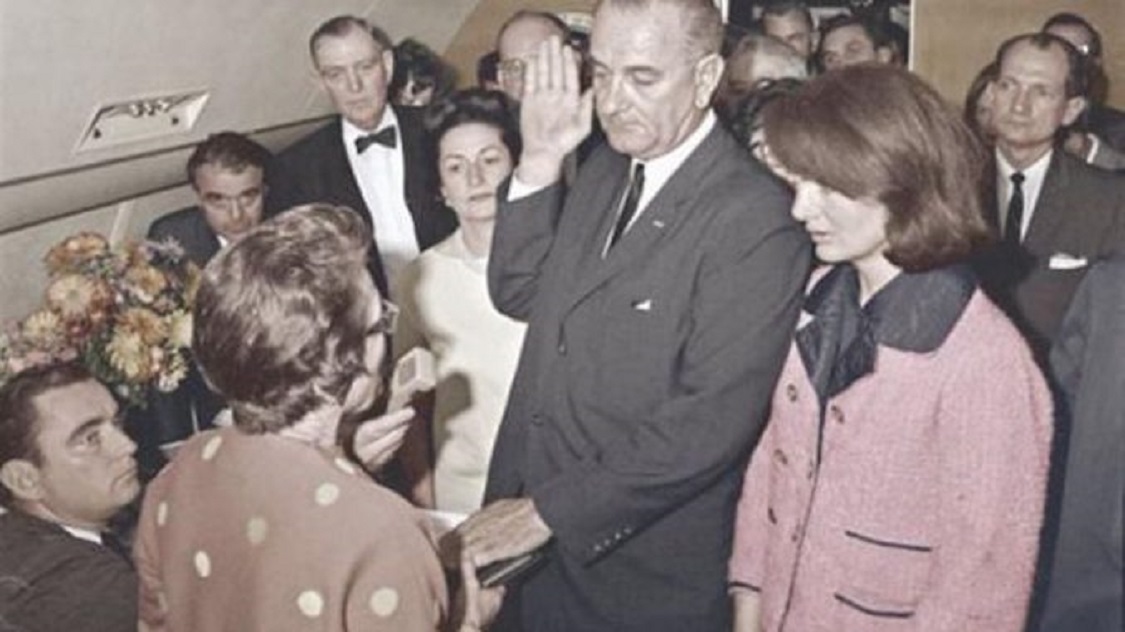 Lyndon
Johnson taking the Oath of Office, November 22, 1963, aboard Air Force
One at Love Field, Dallas Texas, as a dazed and bloodstained Jacqueline
Kennedy stands at his side, staring ahead.President Lyndon B. Johnson
takes the oath of office aboard Air Force One at Love Field in Dallas,
Texas, following the assassination of President John F. Kennedy. Jackie
is angled in such a way as to hide the blood on her coat. It’s the
perfect image reflect the American Pain of the moment, the quick need
for seamless succession, and yet, and yet, in that relatively desperate
moment, attention is still given to the gloss and optics of how the
whole thing is presented.
Lyndon
Johnson taking the Oath of Office, November 22, 1963, aboard Air Force
One at Love Field, Dallas Texas, as a dazed and bloodstained Jacqueline
Kennedy stands at his side, staring ahead.President Lyndon B. Johnson
takes the oath of office aboard Air Force One at Love Field in Dallas,
Texas, following the assassination of President John F. Kennedy. Jackie
is angled in such a way as to hide the blood on her coat. It’s the
perfect image reflect the American Pain of the moment, the quick need
for seamless succession, and yet, and yet, in that relatively desperate
moment, attention is still given to the gloss and optics of how the
whole thing is presented.

